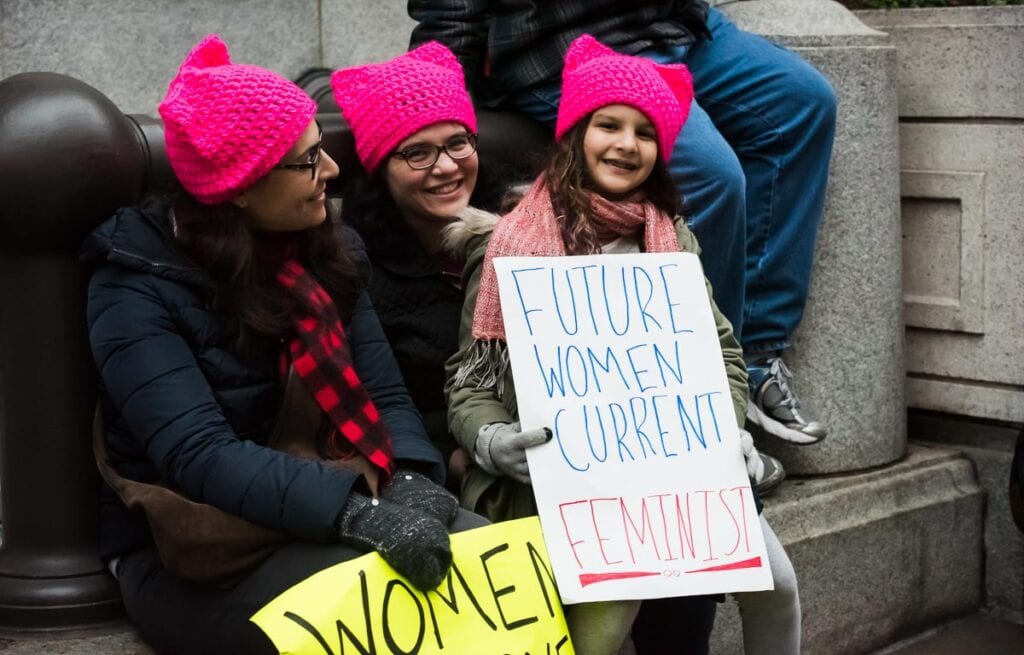How are we teaching our children about the Women’s Rights Movement in America?
On Thursday, I took my daughter to Half the Sky Live, a live movie event inspired by the best-selling book that features stories of women who are overcoming oppression.
It was an inspiring program, not least because it was introduced by a Girl Scout Ambassador, a senior in high school, who told my daughter that speaking up for women’s rights is something that she can do too.
It also got me thinking about ways to teach kids about the Women’s Rights Movement on, and beyond, International Women’s Day.

Table of Contents
- What Is The Women’s Rights Movement?
- How To Teach Kids About The Women’s Rights Movement:
What Is The Women’s Rights Movement?
The women’s rights movement has been a long and ongoing battle for gender equality between women and men, dating back to the women’s rights convention in the late 19th century. Over the years, women have fought for the right to vote, to work outside the home, to receive equal pay, and to have control over their own bodies. The movement has made significant progress, but there is still work to be done.
The first wave of the women’s rights movement began in the late 19th century and continued through the early 20th century. During this time, women fought for the right to vote and for legal protection against discrimination based on gender. In 1920, the 19th Amendment to the U.S. Constitution was ratified, giving women the right to vote.
The second wave of the women’s rights movement began in the 1960s and continued through the 1980s. During this time, women fought for reproductive rights, equal pay, and an end to sexual harassment and discrimination in the workplace. The movement also focused on issues related to sexuality, such as access to birth control and the right to safe and legal abortions.
Today, the women’s rights movement continues to fight for gender equality in a variety of areas. Women are still paid less than men for doing the same work, and they continue to fight for banning employment discrimination and harassment. There is also ongoing debate over women’s reproductive rights and access to healthcare.
The women’s rights movement has seen many prominent leaders, such as Nancy Pelosi, the first woman to serve as Speaker of the House of Representatives, and has been influenced by different waves of feminism throughout history, including during the World War II era when women’s participation in the workforce shifted gender roles, leading to the establishment of the United States Women’s Bureau and more recently, the #MeToo movement has brought attention to the prevalence of violence against women in society.
Despite progress, the number of women in leadership positions remains disproportionately low, with women holding just 27% of seats in the House of Representatives, and issues such as domestic violence continue to be a pressing concern.
However, there have been victories along the way, such as the Violence Against Women Act, signed into law in 1994 by President Bill Clinton, and the election of Kamala Harris as the first woman Vice President of the United States. The movement is ongoing, with events such as the Women’s March in New York City and around the world, continuing to raise awareness and push for change, and calls for gender equality continue to be heard at the highest levels, with the Biden administration committing to appointing a diverse and representative cabinet, including a record number of women and women of color, to serve in the White House.
Despite the challenges that still exist, the women’s rights movement has made significant progress over the years. Women now have more opportunities than ever before to succeed in all areas of life. It’s important to continue to support the movement and work towards a future where gender equality is the norm.
How To Teach Kids About The Women’s Rights Movement:
1. Explore Women’s Rights Movement In NY History
Check out the installation at the NYS museum exhibit featuring artifacts and images from the New York Suffragettes movement of the early 20th century. Warning: if you blink, you might miss it. The entire exhibit consists of a wagon and flag, with signs explaining their significance.
2. Day Trip To Women’s Rights National Park
At 3 hours each way, it’s a long drive from Albany to Seneca Falls, NY, but it’s well worth the effort to visit the site of the Seneca Falls Convention which has been described as the “revolutionary beginning to the struggle by women for complete equality with men.”
If you have a little more time, consider a weekend getaway in Seneca Falls NY. While there you can also visit the National Women’s Hall of Fame.
3. Attend A Local Girl Scout Program
You don’t have to be a Girl Scout, or adult volunteer, to attend a Girl Scout program. Girl Scouts of Northeastern NY hosts a variety of programs throughout the year that are open to girls who are not Girl Scouts.
4. Visit a Local History Museum
Hart Cluett Museum – 57 2nd Street, Troy, NY 12180-3928, (518) 272-7232. In addition to museum exhibits, the Hart Cluett Museum (formerly the Rensselaer County Historical Society) offers several Women’s History programs. Call or visit the website to find out more.
5. Learn about the Women’s Rights Movement Online
- Suffrage Wagon News Channel – A labor of love and a valuable historical resource created by descendants of NY suffragettes.
- 2010: Writing Women Back Into History – The National Women’s History Project.
- Girl Museum – Celebrating girlhood worldwide with online exhibits, daily heroines blog, and more.
- Teaching Women’s Suffrage – PBS gathers a collection of video clips, lesson plans, and primary sources.
- Women’s Suffrage Teaching Guide – Scholastic provides lesson plans sorted by grade level, covering Grades 1-8th.
- Womens Rights – Primary source documents and teaching activities from The National Archives.
- 19 Ways To Teach the 19th Amendment – Activities and current event connections from The New York Times.
- National American Women Association – Collection of materials documenting the National American Woman Suffrage fight.
6. Participate In The International Women’s Movement
International Women’s Day comes around once every year. This year it falls on Friday, March 8, 2023 and the theme is #EmbraceEquity:
But you don’t have to wait until next year to get involved. The International Women’s Day website lists a ton of resources to get you going now.
7. Join a Girl Empowerment Program
- Girl Scouts – Join or start a Girl Scouts troop. There’s no better training for the women leader of tomorrow.
- Girl Effect – Learn more, and take action, to promote a better world.
- Girls Inc. – Trained professional mentoring program.
- Girl Talk – Peer-to-peer mentoring programs.
- Girl Up – Start or join a Girl Up Club, a United Nations initiative.

